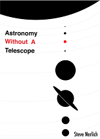Fun with binoculars
The cheap essentials
A pair of 10x50mm binoculars are considered standard for hand-held binocular astronomy. A very acceptable pair can be purchased for under $100  from an astronomy supplier—which ensures they are designed with astronomy in mind.
from an astronomy supplier—which ensures they are designed with astronomy in mind.
Unlike cheap telescopes, cheap binoculars are not plagued by characteristic design flaws. The only obvious reason to pay more money is for more magnification. However, you then need to think about buying a stand since any hand tremor will also be magnified. This starts moving you out of the price range a Cheap Astronomer would feel comfortable with.
Useful (and generally standard) features to look for in cheap binoculars include:
- a screw mount fitting allowing them to be fixed to a stand; and
- a single lens focus adjustment, additional to the main focus, to adjust for focal differences
 Just the 10x times magnification will allow you to see thousands more stars than you can do with the naked eye. Unless you have perfect eyesight, or great glasses, you will also see objects with far more clarity than normal.
Just the 10x times magnification will allow you to see thousands more stars than you can do with the naked eye. Unless you have perfect eyesight, or great glasses, you will also see objects with far more clarity than normal.
What to look out for
These are some of Cheap Astronomy’s favorite binocular objects:
- Omega Centauri
- Pleiades (and Southern Pleiades)
- Arcturus, Antares and Betelguese
- The centre of the galaxy
Binoculars are ideal to look at spread out objects in a wide field of view (like the Pleiades). The Moon and planets, like Saturn and Jupiter, are also worth a look. However, these objects have details worth magnifying further through your cheap telescope.
Surprisingly, there is an opportunity to contribute to a genuine scientific endeavour through making regular observations of variable stars through cheap binoculars. It requires a bit of time, dedication and effort and (needless to say) Cheap Astronomy is yet to have go, but if you are keen, more information can be found here.
The most fun
Hand-held binoculars are perfectly designed to scan huge expanses of the skies, so go ahead and do just that. Sure, everything you see will have been seen and catalogued by someone else years ago, but so what?
For example, following the line of the Milky Way will bring a whole range of unusual objects into view. Anything striking is bound to have a name, so get a rough idea of where it is and then log into a virtual planetarium like Stellarium and find out its name. Then look it up in Wikipedia and found out more than you could possibly need to know about it.
What you will be doing here is mixing observation with a bit of research, which is pretty much what astronomy is all about.




